Modern companies struggle with finding the right data across their growing tech stacks. DataHub offers the strongest governance features, Amundsen provides the easiest setup and deployment, while Atlan delivers the most comprehensive enterprise-ready solution. Each tool takes a different approach to solving the same core problem of data discovery and management.
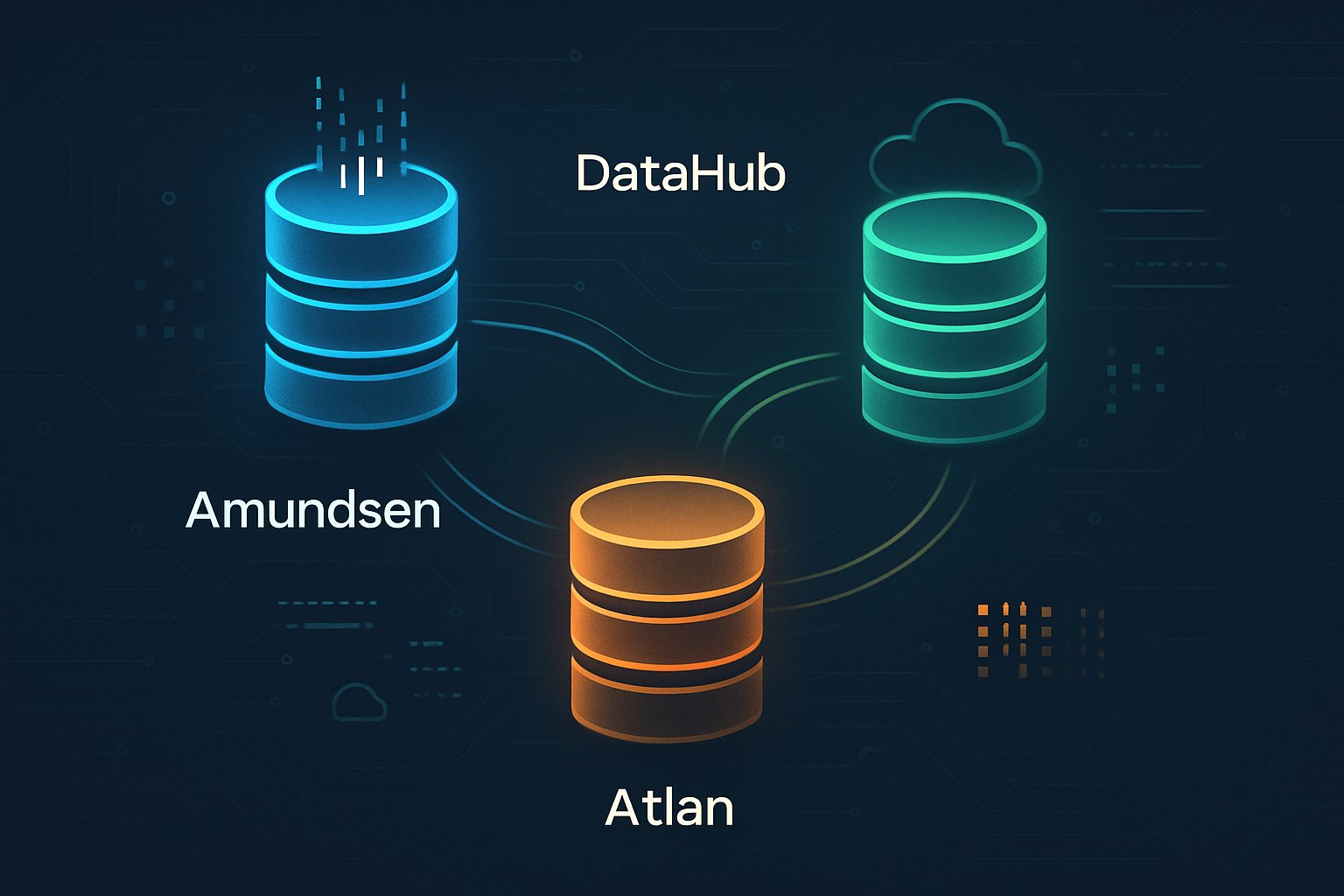
These three platforms represent the leading options for automated data cataloging in 2025. DataHub brings LinkedIn’s battle-tested metadata platform with advanced column-level lineage tracking. Amundsen offers Lyft’s lightweight solution that focuses on simplicity and multiple backend support. Atlan combines open-source flexibility with enterprise features designed for large-scale deployments.
The choice between these tools depends on your team’s technical needs, existing infrastructure, and long-term data strategy. Understanding their core differences in architecture, governance capabilities, and integration options will help you pick the right solution for your organization’s data catalog requirements.
Key Takeaways
- DataHub excels at data governance with fine-grained access controls while Amundsen offers easier deployment and Atlan provides enterprise-grade features
- All three platforms support essential data catalog functions like search, discovery, lineage tracking, and metadata management across multiple data sources
- The decision should be based on your organization’s technical requirements, existing infrastructure, and whether you need open-source flexibility or commercial support
Understanding Automated Data Catalogs

Automated data catalogs serve as central platforms that automatically collect, organize, and present metadata from various data sources across an organization. These tools enable teams to search, discover, and understand data assets while maintaining proper governance and compliance standards.
Key Features and Components
Automated data catalogs include several core components that work together to manage organizational data assets. The metadata ingestion system automatically extracts information from databases, data warehouses, and other sources without manual intervention.
Search functionality allows users to find specific datasets, tables, or columns quickly. Most data catalogs use Elasticsearch to power their search capabilities, making it easy to locate relevant information.
Lineage tracking shows how data moves through systems. Users can see where data comes from and where it goes. This helps teams understand data dependencies and track changes.
Data classification features automatically tag sensitive information like personal data or financial records. This helps organizations meet compliance requirements for regulations like GDPR.
User interfaces provide easy access to all catalog features. Teams can browse data assets, view documentation, and understand data quality metrics through web-based dashboards.
Role of Metadata in Data Catalogs
Metadata forms the foundation of any data catalog system. It includes technical details like column names, data types, and table structures that help users understand what each dataset contains.
Business metadata adds context that technical details cannot provide. This includes descriptions of what data means, how it should be used, and any business rules that apply.
Operational metadata tracks system performance and usage patterns. Teams can see which datasets are accessed most often and identify potential quality issues before they cause problems.
Data catalogs automatically collect this metadata from source systems. They parse database schemas, extract documentation, and gather usage statistics without requiring manual data entry.
Quality metrics help users evaluate whether data meets their needs. Catalogs can show completeness scores, freshness indicators, and validation results.
Business Context and Data Discovery
Data discovery becomes much easier when business context is available alongside technical metadata. Users can understand not just what data exists, but how it relates to business processes and objectives.
Domain expertise gets captured through user contributions and automated analysis. Subject matter experts can add descriptions and business rules that help others understand data meaning.
Usage patterns show which teams access specific datasets most frequently. This helps new users identify reliable data sources and understand common use cases.
Documentation integration connects data assets to existing business glossaries and process documentation. Teams can see how data supports specific business functions or reporting requirements.
Data catalogs make discovery faster by providing search filters based on business terms, data domains, and usage frequency. Users can find relevant datasets without knowing exact technical names or locations.
Overview of DataHub, Amundsen, and Atlan
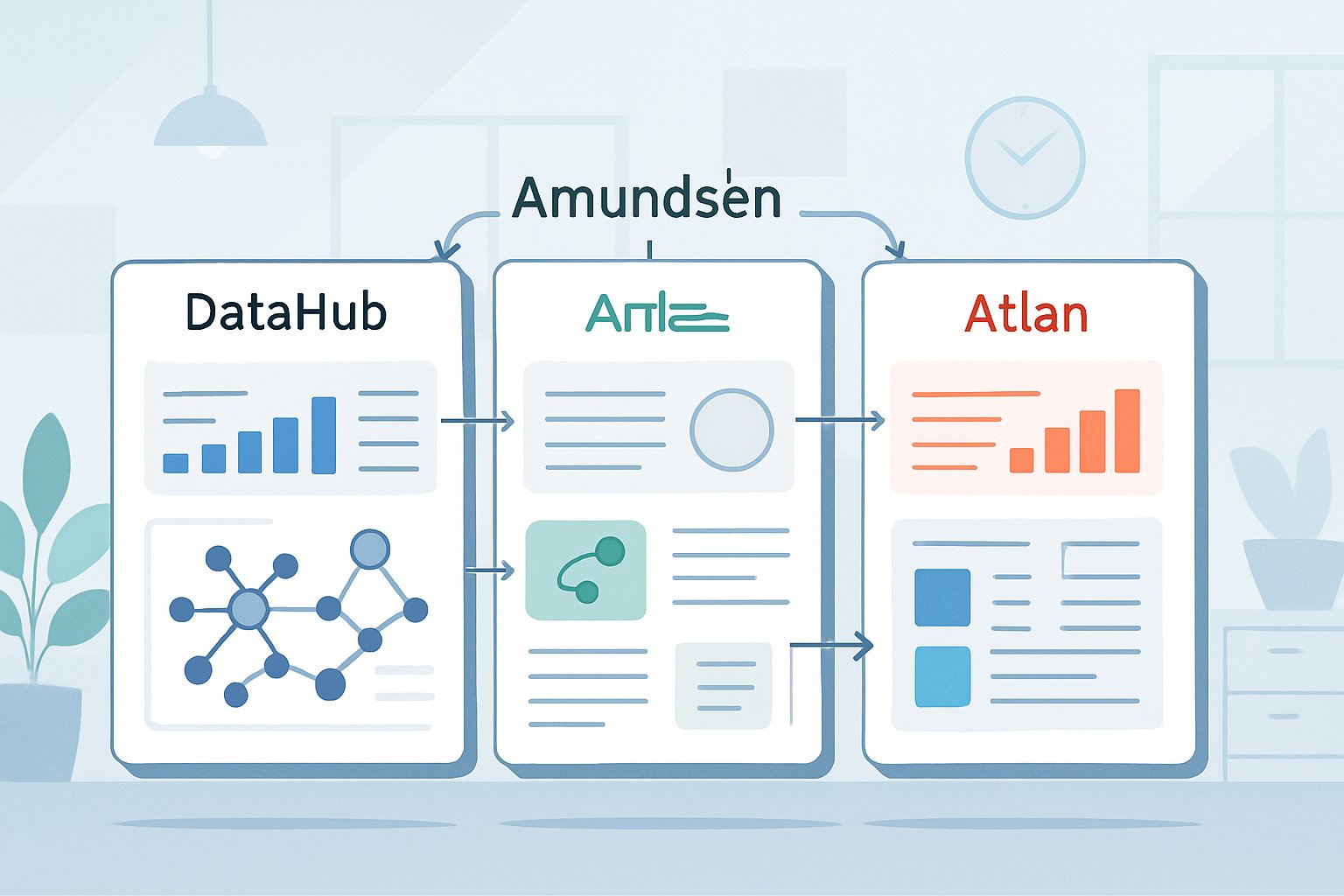
DataHub emerged from LinkedIn as a plugin-based metadata platform, while Amundsen originated at Lyft with an ETL-focused approach. Atlan stands apart as a commercial active metadata platform designed for enterprise-scale data governance.
DataHub Origins and Architecture
LinkedIn created DataHub to democratize data access across their organization. Over 1,500 employees visit DataHub weekly to search and discover data.
DataHub uses a plugin-based metadata ingestion system. Users must install specific plugins for each data source or sink. The platform supports multiple communication methods including REST API, GraphQL, and AVRO-based API over Kafka.
Core Components:
- Database: Neo4j or MySQL
- Search: Elasticsearch
- Ingestion: Source-specific plugins
- Communication: REST API, GraphQL, Kafka
The Python-based metadata ingestion package integrates with DataHub’s CLI tool. Organizations can use the acryl-datahub package in custom Python libraries or integrate with Airflow for complex workflows.
DataHub excels at data governance with column-level classification and PII tagging. The platform supports automatic data deletion for GDPR compliance and offers fine-grained access controls at both dataset and column levels.
Amundsen’s Foundation and Ecosystem
Lyft developed Amundsen to boost their data team productivity by 20%. The platform focuses on simplicity and ease of deployment.
Amundsen built its own ETL framework inspired by Apache Gobblin. The Databuilder ingestion library includes extractors, transformers, and loaders for various sources including Python, Cassandra, Hive, Snowflake, and Databricks.
Architecture Overview:
- Database: Neo4j (primary)
- Search: Elasticsearch
- Ingestion: Databuilder ETL framework
- Communication: REST API
The platform supports multiple backend environments beyond Neo4j, including AWS Neptune and Apache Atlas. This backend flexibility gives Amundsen an advantage over competitors.
Amundsen offers unique preview capabilities that connect the metadata catalog with live databases. Users can view data samples directly within the catalog for better context.
Atlan’s Active Metadata Platform
Atlan positions itself as an enterprise-focused active metadata platform. The company built their solution to address limitations in open-source tools like setup complexity and maintenance overhead.
The platform combines automated metadata discovery with business context and governance features. Atlan targets organizations seeking commercial support and enterprise-grade capabilities.
Key Differentiators:
- Commercial support and maintenance
- Enterprise security features
- Built-in collaboration tools
- Automated data profiling
Atlan offers packaged deployment options that reduce setup time compared to open-source alternatives. The platform includes native integrations with popular data tools and cloud platforms.
The active metadata platform approach means Atlan continuously updates metadata in real-time rather than through batch processes. This provides users with current information about data quality, usage patterns, and lineage.
Data Discovery and Search Capabilities
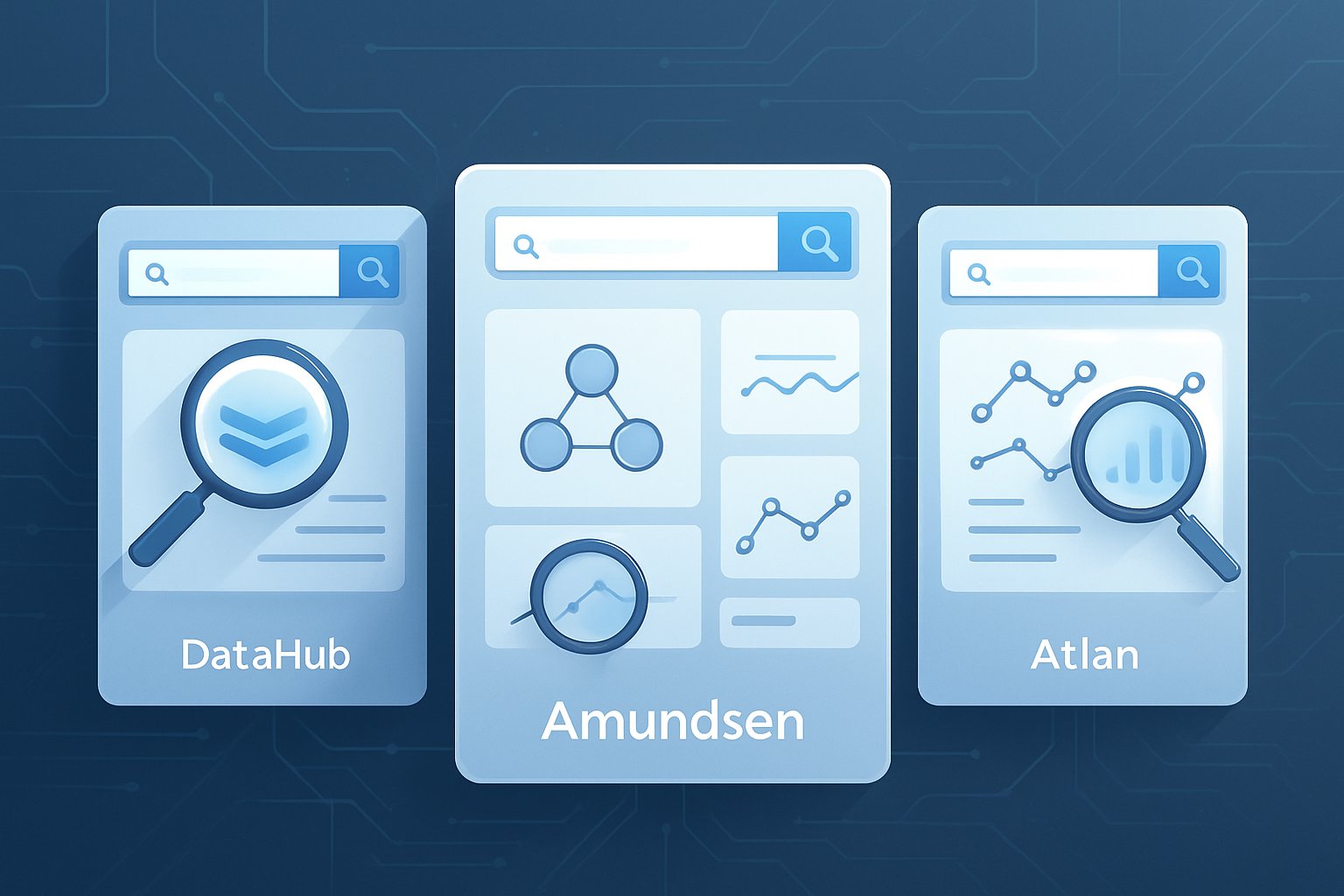
DataHub leverages Google-style search functionality while Amundsen implements page-rank algorithms based on usage patterns. Atlan provides modern search with AI-powered recommendations and collaborative features that enhance team productivity.
Search Experience and Usability
DataHub provides a comprehensive search experience through Elasticsearch integration. Users can search across tables, dashboards, and data assets with advanced filtering options. The platform displays search results with relevance scoring and popularity metrics.
Amundsen uses Elasticsearch for metadata search combined with Neo4j for database relationships. The search interface focuses on simplicity and shows usage statistics to help users find popular datasets. Data analysts can quickly locate tables based on column names, descriptions, and owner information.
Atlan offers modern search capabilities with autocomplete and smart suggestions. The platform provides faceted search options that let users filter by data owners, tags, and asset types. Search results include preview functionality and contextual information.
All three platforms support keyword search across metadata fields. DataHub and Amundsen require technical setup for optimal search performance. Atlan provides pre-configured search optimization as a managed service.
Business Glossary and Collaboration
DataHub includes basic glossary features for defining business terms and linking them to data assets. Users can create term definitions and associate them with datasets. The platform supports collaborative editing through its GraphQL API integration.
Amundsen focuses primarily on technical metadata discovery rather than business glossary functionality. Teams can add descriptions and documentation to data assets. The platform allows data owners to update asset information and maintain data quality notes.
Atlan provides comprehensive business glossary capabilities with approval workflows. Business users can create and manage glossary terms without technical assistance. The platform includes stakeholder management features that connect business terms to data owners and stewards.
Collaboration features vary significantly between platforms. Atlan offers the most business-user-friendly approach with built-in approval processes and notification systems.
Metadata Enrichment and Context
DataHub supports automatic metadata ingestion through source-specific plugins. The platform captures technical metadata, schema information, and data lineage details. Users can add custom properties and tags to enhance asset context.
Amundsen uses its Databuilder framework for metadata extraction from various sources. The platform stores metadata in Neo4j and provides relationship mapping between assets. Data owners can enrich assets with business context and usage documentation.
Atlan combines automated metadata collection with manual enrichment capabilities. The platform captures technical metadata while allowing business users to add context through comments and descriptions. AI-powered suggestions help identify relevant tags and classifications.
All three platforms support metadata tagging and classification. DataHub and Amundsen require more technical expertise for metadata management. Atlan provides user-friendly interfaces for both technical and business metadata enrichment.
Data Lineage and Metadata Management
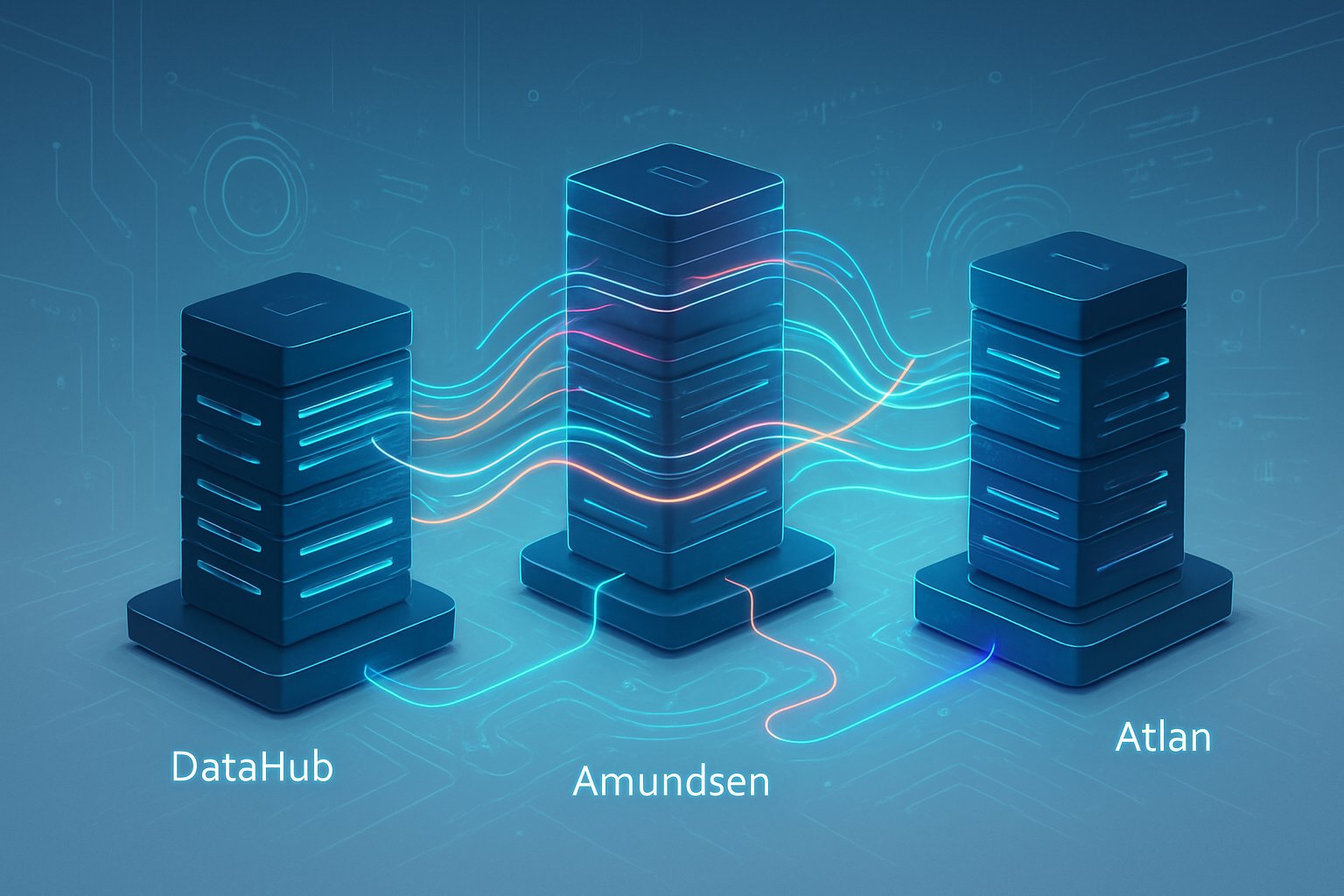
DataHub excels at automated lineage tracking through its streaming architecture, while Amundsen focuses on table-level relationships and Atlan provides enterprise-grade governance features. Each platform handles column-level granularity and data platform integrations differently.
Automation of Data Lineage
DataHub uses a stream-based metadata platform that automatically captures lineage information in real-time. The system processes metadata changes through Kafka events and REST API calls. This approach eliminates manual tracking efforts.
The platform automatically detects data transformations from dbt models. Users see lineage updates within minutes of pipeline executions. DataHub’s Python-based ingestion package connects to source systems without custom coding.
Amundsen requires more manual setup for lineage automation. The Databuilder framework extracts lineage information during scheduled runs. Users must configure extractors for each data source they want to track.
The system works well with Airflow for orchestration. However, lineage updates happen during batch processing windows rather than continuously.
Atlan provides automated lineage discovery across enterprise data platforms. The system captures lineage from SQL queries, ETL tools, and business intelligence platforms. Users benefit from pre-built connectors that require minimal configuration.
Lineage Granularity (Table vs Column)
DataHub supports both table-level and column-level lineage tracking. The platform added column-level lineage in late 2022 and continues improving this feature. Current versions support column lineage for Airflow, dbt, Redshift, and Power BI.
Users can visualize how individual columns flow through transformations. This granular view helps with impact analysis and compliance reporting.
Amundsen traditionally focused on table-level lineage but added column-level support in recent releases. The 2023 updates included column-level lineage for various data sources. However, this feature remains less mature than DataHub’s implementation.
The platform shows relationships between tables clearly. Column-level details require additional configuration and may not work for all data sources.
Atlan delivers comprehensive lineage at both table and column levels. The platform automatically maps column transformations across complex data pipelines. Users see detailed lineage graphs showing field-level dependencies.
Integration with Data Platform
DataHub integrates with over 50 data platforms through source-specific plugins. The system connects to modern data stacks including Snowflake, Databricks, and cloud data warehouses. Kafka integration enables real-time metadata streaming from operational systems.
The platform supports GraphQL and AVRO-based APIs for flexible integrations. Development teams can build custom connectors using the Python SDK.
Amundsen offers more than 20 database connectors for metadata ingestion. The platform works well with AWS Glue and supports various dashboard tools like Superset. Generic connectors provide extensibility without custom development.
Backend flexibility sets Amundsen apart. Users can choose between neo4j, AWS Neptune, or Apache Atlas for metadata storage.
Atlan provides enterprise-grade integrations with major data platforms. The system includes pre-built connectors for popular tools in the modern data stack. Native dbt integration captures model documentation and lineage automatically.
The platform handles complex enterprise architectures with multiple data sources. Integration workflows require less technical expertise compared to open-source alternatives.
Data Governance, Security, and Compliance
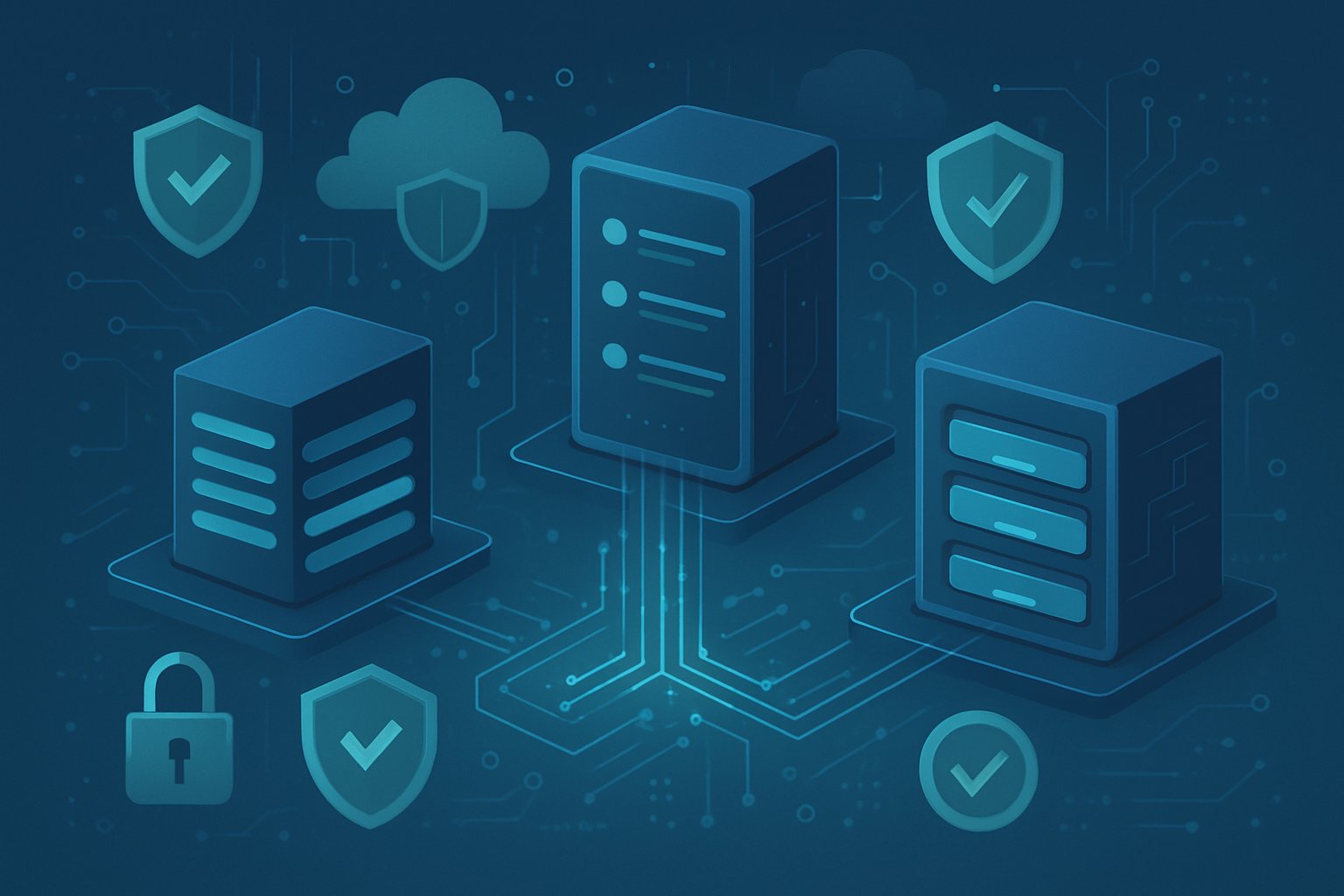
Data governance capabilities vary significantly across these platforms, with DataHub offering the most advanced compliance features, while Amundsen focuses on backend flexibility and Atlan provides enterprise-grade managed governance tools.
Access Control and Authentication
DataHub leads in authentication options with support for both OAuth OIDC and JaaS (Java Authentication and Authorization Service). The platform provides fine-grained access controls at both dataset and column levels. DataHub enables administrators to set platform and metadata policies that restrict user access based on roles and permissions.
Amundsen supports OAuth OIDC authentication but has limited authorization features. The platform’s authorization capabilities remain in development according to their roadmap. Users can authenticate through standard protocols, but granular access controls are not yet fully implemented.
Atlan offers enterprise-grade authentication and authorization as a managed service. The platform integrates with existing identity providers and supports role-based access controls. Organizations can define user permissions without managing the underlying infrastructure.
Data Quality and Ownership
DataHub excels in data ownership features with automated data classification and PII tagging capabilities. The platform supports automatic data deletion to help organizations comply with GDPR requirements. Data owners can define business rules that establish data quality standards and configure compliance integrations.
DataHub’s column-level lineage tracking helps data owners understand data movement and transformation across systems. This visibility supports data quality initiatives by showing exactly how data flows through different processes.
Amundsen provides basic data ownership capabilities through its metadata catalog. Data owners can document datasets and establish clear lineage during development. The platform’s preview feature allows users to connect with live databases to verify data quality.
Atlan offers automated data quality monitoring with built-in governance workflows. The platform uses machine learning to identify data quality issues and can automatically tag and classify data at scale.
Compliance with Regulations
DataHub provides the strongest compliance capabilities among the three platforms. The system supports GDPR compliance through automated data deletion features and comprehensive PII tagging. Organizations can implement data governance policies that align with regulatory requirements like HIPAA and other privacy standards.
The platform’s fine-grained access controls help organizations meet compliance requirements by restricting access to sensitive data. DataHub’s audit trails track data access and modifications for compliance reporting.
Amundsen offers basic compliance features through its data classification and tagging system. Organizations can implement data governance policies, but the compliance features are less comprehensive than DataHub’s offerings.
Atlan provides enterprise compliance tools as part of its managed service. The platform includes automated compliance monitoring and can help organizations meet various regulatory requirements through its governance automation features.
Integration with Data Infrastructure and Platforms

Modern data catalogs must integrate seamlessly with cloud data platforms and lakehouse architectures. Each tool offers different approaches to connecting with popular query engines like Snowflake and Databricks.
Support for Modern Data Lakes
DataHub provides native connectors for major lakehouse platforms including Snowflake, Databricks, and Delta Lake. The platform automatically extracts metadata from these systems through its plugin architecture.
Amundsen supports data lake integration through its Databuilder framework. It connects directly to Snowflake, Databricks, and Hive environments. The tool also integrates with AWS Glue for serverless data discovery.
Atlan offers warehouse-native capabilities for Snowflake, BigQuery, and Databricks. Users can analyze data behavior directly within their cloud platforms without moving data.
Apache Iceberg and Hudi table formats work with all three catalogs through their respective database connectors. DataHub provides specific plugins for these formats. Amundsen handles them through generic extractors.
Compatibility with Query Engines
DataHub connects to query engines through source-specific plugins. It supports Snowflake, Databricks SQL, and traditional Hadoop clusters. The platform ingests query logs and execution metadata.
Amundsen integrates with query engines using its extractor framework. It pulls metadata from Snowflake, Databricks, Postgres, and Cassandra. The tool tracks query patterns and usage statistics.
Unity Catalog integration is available in DataHub through Databricks connectors. Amundsen accesses Unity Catalog metadata through its Databricks extractor. Atlan provides direct Unity Catalog support.
DuckDB and other analytical engines connect through custom extractors in both open-source tools. Atlan offers broader engine support through its managed platform.
Ecosystem Integrations
DataHub integrates with streaming platforms like Apache Kafka and Samza. It supports real-time metadata ingestion and GraphQL APIs. The platform connects to orchestration tools including Airflow.
Amundsen works with Apache Atlas as a backend metadata store. It integrates seamlessly with Airflow for scheduled workflows. The tool supports REST API communication across all components.
Both platforms connect to dashboard tools like Superset and Power BI. They extract metadata from visualization layers and track data lineage.
Polaris Catalog and Tabular integrations are emerging in both tools. DataHub offers experimental support through custom connectors. Amundsen handles these through its generic extractor patterns.
Open Source vs Enterprise Solutions
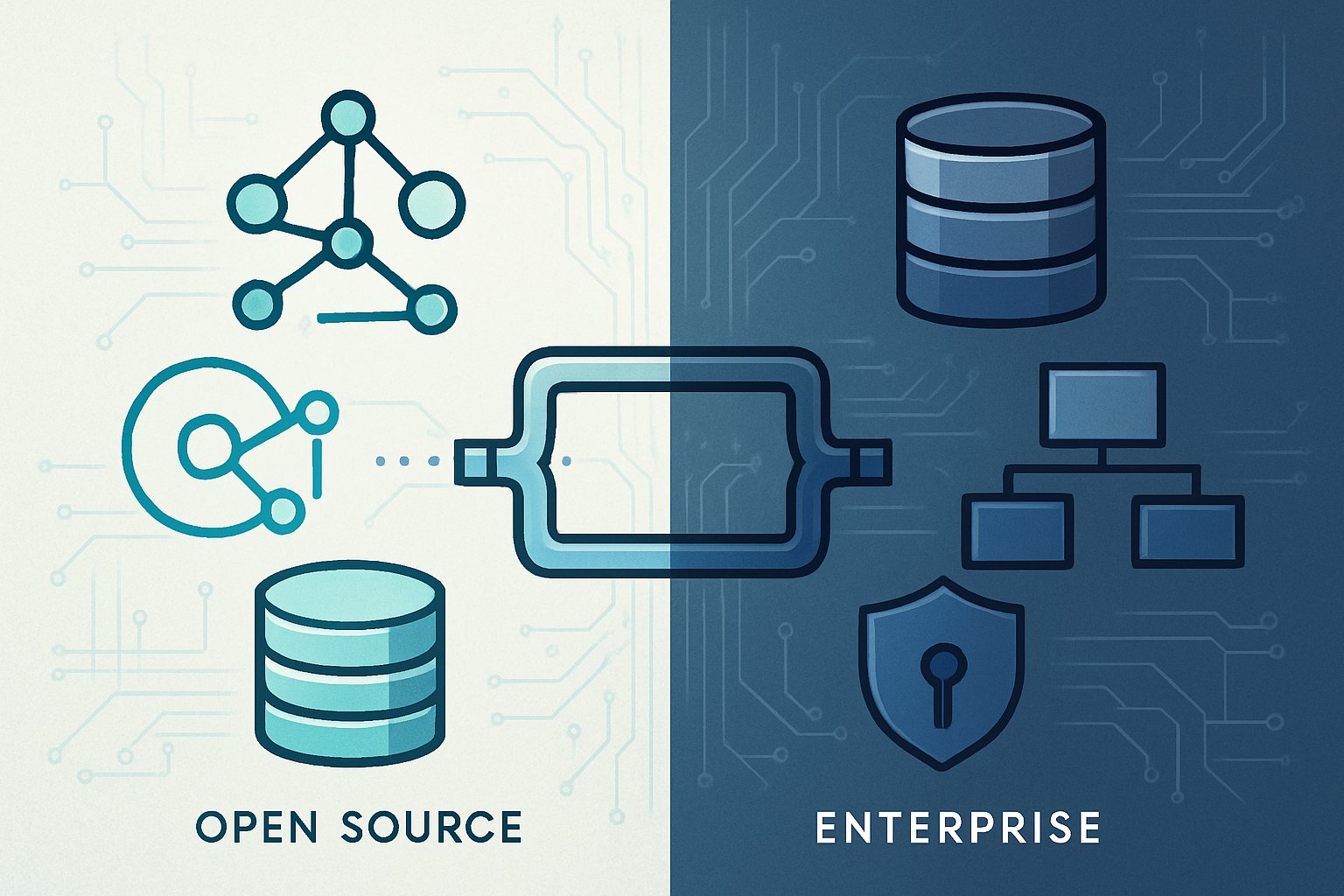
Open source data catalogs offer cost advantages but require technical expertise, while enterprise solutions provide professional support at higher costs. The choice depends on team size, technical capabilities, and long-term maintenance resources.
Sustainability and Community Support
Open source data catalog tools rely heavily on community contributions for updates and bug fixes. DataHub benefits from LinkedIn’s backing and maintains an active development community with frequent releases. Amundsen faces uncertainty after transitioning to the Linux Foundation, with outdated documentation and unclear roadmaps.
Apache Atlas enjoys stability through the Apache Software Foundation but focuses primarily on Hadoop ecosystems. The tool has well-documented releases tracked through Jira, though its interface appears dated compared to newer alternatives.
Enterprise solutions like Atlan provide dedicated support teams and guaranteed service level agreements. Companies receive regular updates without depending on volunteer contributors. This approach ensures consistent maintenance and feature development aligned with business needs.
Cost and Deployment Considerations
Open source data catalog implementations require significant internal resources for setup and maintenance. Organizations need skilled engineers familiar with technologies like Neo4j, Elasticsearch, and PostgreSQL. Infrastructure costs include hosting, monitoring, and backup systems.
Enterprise data catalog solutions charge licensing fees but include professional services, implementation support, and ongoing maintenance. The total cost often proves comparable when factoring in internal resource requirements for open source deployments.
Deployment complexity varies significantly between options. DataHub and Amundsen require multiple service components and external dependencies. Enterprise solutions typically offer streamlined installation processes and managed hosting options.
Use Cases for Different Organization Sizes
Small to medium companies often choose open source data catalog tools to minimize upfront costs. These organizations typically have dedicated engineering teams capable of managing technical infrastructure. Limited data volumes make maintenance more manageable.
Large enterprises frequently select commercial solutions due to compliance requirements and support needs. Complex data environments with hundreds of sources require robust governance features and professional assistance. Enterprise data teams value guaranteed response times for critical issues.
Organizations using Apache Atlas often operate within existing Hadoop ecosystems where integration benefits outweigh modernization costs. This approach works well for companies with established big data infrastructure and specialized technical knowledge.
Future Trends and Key Considerations
Data catalog platforms are evolving beyond static repositories into dynamic systems that actively manage and automate metadata operations. The focus shifts toward real-time synchronization across platforms and establishing clear data contracts that enable better collaboration between teams.
Active Metadata and Automation
Active metadata platforms represent the next evolution in data catalog technology. These systems move beyond passive storage to actively monitor, update, and respond to changes in data environments.
DataHub leads this trend with its real-time event streaming capabilities through Kafka. The platform automatically captures schema changes, data quality issues, and usage patterns without manual intervention.
Amundsen focuses on automated discovery through its Databuilder framework. The system extracts metadata changes from source systems and updates the catalog continuously.
Key automation features include:
- Automatic schema drift detection
- Real-time lineage updates
- Smart data quality monitoring
- Usage-based recommendations
Atlan combines both approaches with AI-powered automation that learns from user behavior. The platform suggests tags, classifications, and ownership assignments based on usage patterns.
Multi-Platform Synchronization
Modern organizations use multiple data platforms simultaneously. Future catalogs must synchronize metadata across cloud providers, on-premise systems, and hybrid environments seamlessly.
DataHub supports this through its plugin architecture and GraphQL API. Teams can connect multiple instances and maintain consistent metadata across different environments.
Amundsen handles synchronization through its support for multiple backends including neo4j, AWS Neptune, and Apache Atlas. This flexibility allows organizations to maintain distributed catalogs while keeping them synchronized.
Critical synchronization challenges:
- Schema mapping between different systems
- Maintaining data lineage across platforms
- Consistent access controls and permissions
- Real-time updates without conflicts
The trend moves toward federated catalog architectures where each platform maintains its local catalog while participating in a larger metadata ecosystem.
Evolving Data Contracts and Collaboration
Data contracts emerge as formal agreements between data producers and consumers. These contracts define schemas, quality standards, and service level agreements for data assets.
DataHub integrates data contracts through its governance features. Teams can define column-level policies, data quality rules, and access permissions that automatically enforce contract terms.
The platform supports contract versioning and change management. When producers modify data structures, consumers receive notifications about contract changes before they take effect.
Data engineering teams benefit from automated contract validation. The system checks incoming data against defined contracts and flags violations before they reach downstream consumers.
Collaboration features expand beyond basic discovery. Modern catalogs include:
- Slack and Teams integrations for real-time notifications
- Comment systems for technical discussions
- Change request workflows for schema modifications
- Impact analysis tools that show downstream effects
Amundsen and DataHub both support these collaborative workflows through their REST APIs and integration capabilities. Teams can embed catalog functionality directly into their existing development tools and processes.
Frequently Asked Questions
These tools differ significantly in architecture, deployment complexity, and specialized features. Integration capabilities, user interface design, and metadata handling approaches vary considerably between open-source and commercial solutions.
What are the key features that differentiate Automated Data Catalog tools like DataHub, Amundsen, and Atlan?
DataHub excels in data governance with fine-grained access controls and column-level classification. It supports PII tagging and automatic data deletion for GDPR compliance. The platform offers column-level lineage for Airflow, dbt, Redshift, and Power BI.
Amundsen focuses on simplicity and backend flexibility. It supports multiple backend environments including neo4j, AWS Neptune, and Apache Atlas. The platform features unique data preview capabilities that connect catalogs with live databases.
Atlan operates as a commercial solution with enterprise-grade features. It combines the agility of open-source tools with professional support and advanced scalability options.
DataHub uses plugin-based metadata ingestion while Amundsen employs an ETL-based approach. DataHub supports GraphQL, REST API, and Kafka communication protocols.
How do Automated Data Catalogs like Atlan, DataHub, and Amundsen integrate with existing data ecosystems?
DataHub integrates through source-specific plugins that work with its Python-based ingestion package. Users must install relevant plugins for each data source or sink. The platform connects seamlessly with Kafka events and REST API calls.
Amundsen uses its Databuilder library with extractors, transformers, and loaders. It supports Python, Cassandra, Hive, Snowflake, Postgres, and Databricks through built-in extractors.
Both tools integrate with Apache Airflow for complex workflows. DataHub offers additional integration through its CLI tool and custom Python libraries.
Amundsen provides over twenty database connectors and multiple dashboard connectors. It supports AWS Glue and Superset for extended functionality without custom development.
What are the main advantages of using Amundsen over other data catalog solutions?
Amundsen offers superior backend support compared to other open-source alternatives. It works with neo4j as the default backend plus AWS Neptune and Apache Atlas options.
The platform provides unique data preview functionality. Users can view live data samples directly within the catalog interface for better context and understanding.
Amundsen emphasizes ease of deployment and modification. The architecture remains straightforward for teams to understand, install, and customize according to specific needs.
The tool requires minimal prerequisites for deployment. Teams only need Docker, Docker Compose, and Python or Node.js versions to get started quickly.
In terms of user experience and ease of use, how do DataHub, Amundsen, and Atlan compare?
Amundsen prioritizes simplicity in its user interface and deployment process. The platform maintains an intuitive design that reduces the learning curve for new users.
DataHub released an updated search and discovery experience in September 2023. The new interface allows users to visualize column-level lineage relationships through Airflow DAGs and other tools.
Atlan provides enterprise-level user experience with professional support. The commercial platform offers dedicated assistance and training resources for implementation teams.
DataHub requires more technical knowledge for plugin installation and configuration. Users must understand specific integration requirements for each data source.
Can you explain how DataHub handles metadata management compared to Amundsen and Atlan?
DataHub uses a plugin-based system maintained by Acryl Data for metadata ingestion. Each data source requires specific plugin installation and configuration steps.
The platform supports multiple communication protocols including REST API, GraphQL, and AVRO-based API over Kafka. This flexibility allows integration with various streaming and batch processing systems.
Amundsen employs an ETL framework inspired by Apache Gobblin with built-in orchestration capabilities. The Databuilder library handles extraction, transformation, and loading through modular components.
DataHub stores metadata in neo4j or MySQL databases with Elasticsearch for search functionality. Amundsen uses neo4j as the primary database with Elasticsearch for metadata search capabilities.
What are some considerations when choosing between open-source data catalogs like Apache Atlas, Amundsen, and DataHub?
Technical requirements play a crucial role in selection decisions. Teams should evaluate backend database preferences, integration complexity, and available technical expertise.
DataHub suits organizations requiring advanced governance features and fine-grained access controls. The platform works well for companies with complex compliance requirements like GDPR.
Amundsen fits teams prioritizing quick deployment and backend flexibility. Organizations with existing Atlas or Neptune infrastructure benefit from its multiple backend support.
Community support and development activity differ between platforms. DataHub maintains active development through LinkedIn and Acryl Data commercial backing.
Deployment complexity varies significantly between options. Amundsen offers simpler setup processes while DataHub requires more configuration for full functionality.




